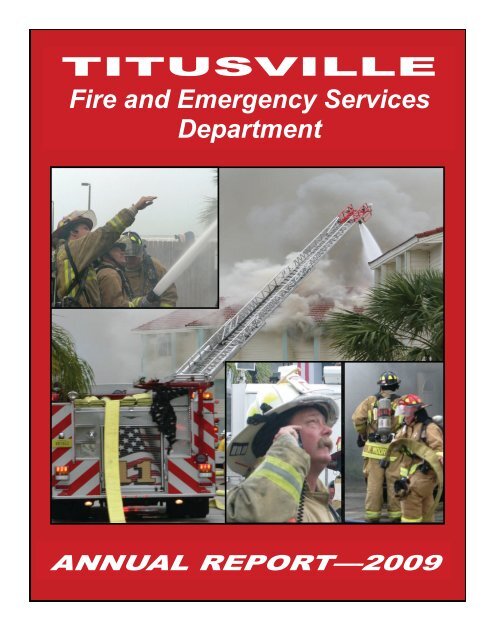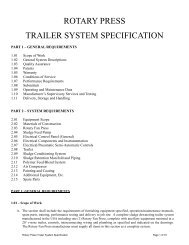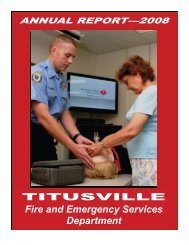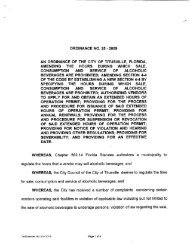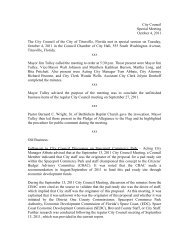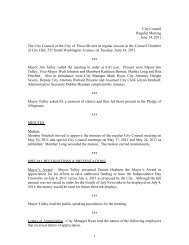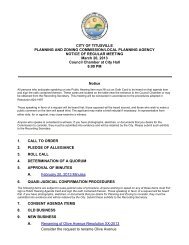annual report-2009.pdf - The City of Titusville, Florida
annual report-2009.pdf - The City of Titusville, Florida
annual report-2009.pdf - The City of Titusville, Florida
Create successful ePaper yourself
Turn your PDF publications into a flip-book with our unique Google optimized e-Paper software.
TITUSVILLE<br />
Fire and Emergency Services<br />
Department<br />
ANNUAL REPORT—2009
Motto: Service doesn’t come from a<br />
manual—it comes from the heart.<br />
It is with great pleasure that I present the <strong>Titusville</strong> Fire and Emergency Services<br />
Department’s 2009 Annual Report. This <strong>report</strong> provides an overview <strong>of</strong> the services that our<br />
department provides and identifies our accomplishments over the past year. As you will see<br />
we have not been just a “fire” department for a number <strong>of</strong> years. We are an all hazards<br />
emergency department that responds to medical calls, vehicle accidents, water emergencies<br />
as well as other types <strong>of</strong> emergency and non-emergency calls for service. It is our goal to<br />
help our community stay safe and help our citizens during their time <strong>of</strong> need.<br />
We understand the difficulty <strong>of</strong> these hard economic times as we also struggle to provide the<br />
necessary services with dwindling funds. However, we will continue to do the best that we<br />
can to serve you with the resources we are provided. We continually look for ways to obtain<br />
alternative funding to help <strong>of</strong>fset the cost <strong>of</strong> our services or partner with others in the<br />
community.<br />
Partnerships allow us to provide services to the community that we would otherwise not be<br />
able to provide. Many <strong>of</strong> these programs are proactive to better ensure our community’s<br />
safety by providing injury prevention and fire prevention instruction, child safety seat<br />
installations and CPR classes. We provide Vials <strong>of</strong> Life, bicycle helmets, child safety seats,<br />
carbon monoxide and smoke detector installations to those in need.<br />
Our community volunteer program also assists the department in meeting many <strong>of</strong> our dayto-day<br />
<strong>of</strong>fice activities. Without their contributions, we would not be able to provide the<br />
support we do at fire headquarters.<br />
Our fire prevention division does a wonderful job <strong>of</strong> ensuring our business community<br />
remains vigilant in their fire safety practices. <strong>The</strong> division also monitors new construction<br />
and commercial alterations to ensure compliance with all fire codes. <strong>The</strong>ir diligence protects<br />
both our firefighters and citizens from the detrimental impacts <strong>of</strong> fires, with little support<br />
from ad valorem taxes.<br />
One does not fully understand all <strong>of</strong> the detrimental effects <strong>of</strong> a fire, a motor vehicle crash<br />
with injuries, or a major medical event until they experience it for themselves. It is our hope<br />
that you will never need our services but, in the event that you do, we pledge to provide you<br />
with the best services available for your emergency situation.<br />
In your service,<br />
Charles R. Bogle<br />
Fire Chief<br />
Post Office Box 2806 <strong>Titusville</strong>, FL 32781-2806 (321) 383-5708 www.titusville.com
VISION STATEMENT<br />
<strong>Titusville</strong> Fire and Emergency Services Department<br />
shall be the leading provider <strong>of</strong> emergency services<br />
in the community it serves.<br />
MISSION STATEMENT<br />
<strong>The</strong> mission <strong>of</strong> the <strong>Titusville</strong> Fire and Emergency<br />
Services Department is to provide the community with<br />
emergency services by highly trained, pr<strong>of</strong>essional personnel<br />
in an expedient and effective manner. Furthermore, it is our<br />
duty to protect and promote the health, safety and overall<br />
well-being <strong>of</strong> the community we serve.<br />
Our commitment is to:<br />
GUIDING PRINCIPLES<br />
• Promote teamwork<br />
• Respect others<br />
• Be open-minded<br />
• Be progressive and responsive to change<br />
• Encourage input<br />
• Foster a positive and safe work environment<br />
• Encourage and recognize initiative and creativity<br />
• Set goals and achieve results
Fire<br />
Chief<br />
Fire<br />
Chaplains (2)<br />
(Volunteer)<br />
Administrative<br />
Secretary<br />
(Temporary)<br />
OPERATIONS<br />
DIVISION<br />
ADMINISTRATION<br />
DIVISION<br />
Division Chief<br />
<strong>of</strong> Operations<br />
Division Chief <strong>of</strong><br />
Administration<br />
Clerical<br />
Assistant II<br />
BUDGETING/<br />
LOGISTICS<br />
SECTION<br />
PREVENTION/<br />
EDUCATION<br />
SECTION<br />
Community<br />
Volunteers<br />
Secretary<br />
Senior Inspector<br />
EMS/Training<br />
Chief<br />
Battalion<br />
Chief<br />
(3)<br />
Logistics Specialist<br />
Inspector I<br />
(Contractual)<br />
Station 10<br />
Lieutenants (3)<br />
Driver-Ops. (3)<br />
Firefighters (3)<br />
Station 11<br />
Lieutenants (3)<br />
Driver-Ops. (3)<br />
Firefighters (6)<br />
Public Ed./Life Safety<br />
Specialist<br />
Clerical<br />
Assistant I<br />
(P/T)<br />
Station 12<br />
Lieutenants (3)<br />
Driver-Ops. (3)<br />
Firefighters (6)<br />
Station 13<br />
Lieutenants (3)<br />
Driver-Ops. (5)<br />
Firefighters (7)<br />
1
Fire Chief<br />
Charles Bogle<br />
Operations Chief<br />
Michael Woodward<br />
Administration Chief<br />
Scott Gaenicke<br />
2
Robert Allard<br />
EMS/Training Chief<br />
Daryle Blankenship<br />
Battalion Chief<br />
Chris Threlkeld<br />
Battalion Chief<br />
Rod Donh<strong>of</strong>f<br />
Battalion Chief<br />
3
Justin Chase<br />
Senior Fire Inspector<br />
Mark Whorton<br />
Fire Inspector<br />
Reginald Belle<br />
Public Education/Life Safety<br />
Diane Parker<br />
Secretary<br />
LaWanda Park<br />
Assistant II<br />
Ruth Miller<br />
Assistant I/PT<br />
Frank Canada<br />
Logistics Coordinator<br />
Kathy Mosley<br />
Administrative Secretary/PT<br />
4
Firefighter/EMT<br />
Matthew Bowman<br />
Driver-Oper./Paramedic<br />
Tiffany Callahan<br />
Lieutenant/Paramedic<br />
Doug Chamberlain<br />
Driver-Oper./Paramedic<br />
David Cody<br />
Lieutenant/EMT<br />
Michael Chiles<br />
Firefighter/EMT<br />
Bobby Crocker<br />
Firefighter/Paramedic<br />
Thomas Duncan<br />
Firefighter/Paramedic<br />
Daniel Ellis<br />
Firefighter/EMT<br />
Naudere Ghajar-Dowlatshahi<br />
Driver-Operator/EMT<br />
Richard Irvine<br />
Firefighter/Paramedic<br />
Matt Johnson<br />
Firefighter/Paramedic<br />
Ben Lees<br />
Driver Op./Paramedic<br />
Chad Lindquist<br />
Driver-Operator/EMT<br />
John McIntyre<br />
Lieutenant/EMT<br />
Rodney Perry<br />
Lieutenant/EMT<br />
Robert Steinmetz<br />
Firefighter/Paramedic<br />
Michael Abernathy<br />
Firefighter/EMT<br />
Jesse Benton<br />
Lieutenant/EMT<br />
Bill Feagan<br />
Firefighter/EMT<br />
Brian Hahn<br />
Firefighter /Paramedic<br />
Josh Hall<br />
Driv.-Oper./Paramedic<br />
Jeffery Harris<br />
Driv.-Oper./Paramedic<br />
David Higginbotham<br />
Firefighter/EMT<br />
Johnny Higginbotham<br />
Firefighter/EMT<br />
John Hustoles<br />
Lieutenant/Paramedic<br />
Bridget Kozielski<br />
Lieutenant/EMT<br />
Brian Litterilla<br />
Driv.-Oper./Paramedic<br />
Randy Moore<br />
Lieutenant/EMT<br />
Frank Neeld<br />
Firefighter/Paramedic<br />
Lucas Senger<br />
Driv.-Oper./Paramedic<br />
Brook Smith<br />
Firefighter/EMT<br />
William Woznicki<br />
5
Firefighter/EMT<br />
Zackery Boone<br />
Firefighter/Paramedic<br />
Lisa Caron<br />
Lieutenant/EMT<br />
Roland Carpentier<br />
Driv.-Oper./Paramedic<br />
Scott Einkopf<br />
Lieutenant/Paramedic<br />
Jerry Ford<br />
Driver/Operator/EMT<br />
Chris Hitt<br />
Firefighter/Paramedic<br />
Shawn Holbrook<br />
Driv.-Oper./Paramedic<br />
Jeremy House<br />
Lieutenant/EMT<br />
Phillip Jones<br />
Driver-Operator/EMT<br />
Wally Kohler<br />
Lieutenant/Paramedic<br />
Brian Marfitt<br />
Firefighter/Paramedic<br />
David Neeld<br />
Firefighter/Paramedic<br />
Michael Rivas<br />
Driv.-Oper./Paramedic<br />
Brian Strong<br />
Firefighter/Paramedic<br />
Gregory Sutton<br />
Firefighter/Paramedic<br />
Adam Vaknin<br />
<strong>The</strong> combat members <strong>of</strong> the Operations<br />
Division work a 24-hour shift. <strong>The</strong><br />
recurrence <strong>of</strong> these shifts during a<br />
6-week schedule allows them to continue<br />
their college education <strong>of</strong>f-duty.<br />
Due to retirements, the average age<br />
<strong>of</strong> our firefighters has dropped by 4 years<br />
since 2005.<br />
<strong>Titusville</strong>’s Firefighters<br />
# <strong>of</strong> Battalion Chiefs: 3 # also Paramedics: 29 (56% <strong>of</strong> combat)<br />
# <strong>of</strong> Lieutenants: 12 # also EMT: 22 (44%<strong>of</strong> combat)<br />
# <strong>of</strong> Driver-Oper.: 14 Average Age: 34.7 years<br />
# <strong>of</strong> Firefighters: 22 Years <strong>of</strong> Service: 10.78 (averaged)<br />
2-Year Degrees: 10 4-Year Degrees: 5<br />
Over the past 25+ years, our emergency call load has increased by 259%, our coverage area has increased in<br />
square miles by 71.5%, and our emergency responsibilities have increased from fires-only to an all-hazards<br />
emergency environment, but our personnel levels have remained virtually the same.<br />
PERSONNEL LEVELS<br />
1984<br />
1985<br />
1986<br />
1987<br />
1988<br />
1989<br />
1990<br />
1991<br />
1992<br />
1993<br />
1994<br />
1995<br />
1996<br />
1997<br />
1998<br />
1999<br />
2000<br />
2001<br />
2002<br />
2003<br />
2004<br />
2005<br />
2006<br />
2007<br />
2008<br />
2009<br />
80<br />
70<br />
60<br />
50<br />
40<br />
30<br />
20<br />
6
Our department initiated its community volunteer program in 1995. It has become an integral part<br />
<strong>of</strong> our administrative functions and is essential to our departmental operations. In the past 14 years<br />
volunteers have logged 18,190.75 hours <strong>of</strong> service. Dollar costs values these accrued volunteer<br />
hours at $310,516.10*. Although priceless in our eyes, it is amazing that our department has been<br />
enriched by almost a third <strong>of</strong> a million dollars <strong>of</strong> donated services since the program started.<br />
<strong>The</strong>se talented and valued individuals contribute their personal time to assist with varied tasks and<br />
duties: Chaplain, receptionist, cartographer, logistics specialist, author, pro<strong>of</strong>reader, party planner,<br />
filing specialist, spreadsheet enthusiast, photo historian and much more! In 2009, they contributed a<br />
total <strong>of</strong> 1,324.50 hours.<br />
*Adjusted 2009 wage base <strong>of</strong> $17.07 per hour—Bureau <strong>of</strong> Labor Statistics-<strong>Florida</strong> Salary Compensation Survey<br />
Service doesn’t come from a manual—it comes from the heart!<br />
7
<strong>The</strong> majority <strong>of</strong> our department’s<br />
resources are dedicated to the<br />
Operations Division. This<br />
division provides the ‘all hazards’<br />
emergency responses to our<br />
community: structure fires,<br />
medical calls, vehicle accidents,<br />
water rescues, hazardous<br />
materials and more.<br />
But we’re not afraid to show our<br />
s<strong>of</strong>ter side by displaying empathy<br />
and compassion to those in need.<br />
It’s all about providing what is<br />
needed by our citizens to support<br />
their needs—whether they require<br />
fire and medical responses or lift<br />
assists or rescuing their cat<br />
from a tree.<br />
SERVICE DOESN’T COME FROM A MANUAL—<br />
IT COMES FROM THE HEART.<br />
7000<br />
6000<br />
5000<br />
4000<br />
3000<br />
2000<br />
1000<br />
1991 to 2009 (Fire/EMS/Other) Responses<br />
0<br />
91 93 95 97 99 01 03 05 07 09<br />
Fires Other EMS<br />
Vehicle accidents: 290<br />
Poisonings/Drug Ingestions: 51<br />
Carbon Monoxide Incidents: 1<br />
Obstetrical Calls: 12<br />
Animal Rescues: 7<br />
Number <strong>of</strong> drownings: 4<br />
Bicycle accidents 6<br />
Pedestrian accidents 6<br />
Bomb Threats/ WMD Calls: 5<br />
• Aircraft-related emergencies:<br />
2 (0 deaths <strong>report</strong>ed)<br />
• Flight stand-bys for landing <strong>of</strong><br />
large capacity jet liners: 17<br />
• On-site support for the<br />
Valiant Air Command Air Show<br />
8
2009 Calls by Time <strong>of</strong> Day<br />
4-8 p.m.<br />
20%<br />
8-12 p.m. 14%<br />
12-4 a.m. 10%<br />
4-8 a.m. 10%<br />
8-12 a.m.<br />
24%<br />
12-4 p.m.<br />
22%<br />
2009 Calls By Day<br />
Fri<br />
14%<br />
Sat<br />
14%<br />
Sun<br />
15%<br />
Mon<br />
14%<br />
Thu<br />
14%<br />
Wed<br />
15%<br />
Tue<br />
14%<br />
9
2009 Fire Calls<br />
23<br />
4<br />
52<br />
48<br />
32<br />
Natural Vegetation Fires<br />
Special Fires<br />
Rubbish Fires<br />
Vehicle Fires<br />
Structure Fires<br />
1992 to 2009 Fire Response Statistics<br />
300<br />
250<br />
200<br />
150<br />
100<br />
50<br />
0<br />
92 93 94 95 96 97 98 99 00 01 02 03 04 05 06 07 08 09<br />
10
In 2009, smoke detectors<br />
were present in only 54% <strong>of</strong><br />
structural fire calls.<br />
Of detectors present, 1%<br />
failed to signal occupants <strong>of</strong><br />
the presence <strong>of</strong> fire (due to<br />
missing/dead batteries).<br />
False Alarm Billings<br />
$25,000<br />
$23,200<br />
$20,000<br />
$17,980<br />
$18,360<br />
$15,000<br />
$10,000<br />
$5,000<br />
$0<br />
$13,250<br />
$5,220<br />
$1,050 $900<br />
2003 2004 2005 2006 2007 2008 2009<br />
In 2009, the department<br />
responded to a total <strong>of</strong> 295<br />
false fire calls, resulting from<br />
malicious intent calls or<br />
malfunctioning automatic<br />
fire alarms.<br />
11
2009 EMS Calls<br />
55<br />
2148<br />
889<br />
484<br />
322<br />
1158<br />
In 2009, 75.4% <strong>of</strong><br />
emergency calls<br />
fell within the<br />
emergency<br />
medical services<br />
fields.<br />
Other Medical CVA Illness<br />
Trauma Respiratory Cardiac Related<br />
NOTE: OTHER MEDICAL includes such emergencies as: dizziness, insect stings,<br />
heat-related injuries, lightning strikes, patient lift assists, snake bites, etc.<br />
Our units provide<br />
Advanced Life<br />
Support (ALS),<br />
an enhanced<br />
level <strong>of</strong><br />
emergency care<br />
for our<br />
community.<br />
+ Of 1158 trauma calls, 957 required transport to a<br />
hospital facility by ground transportation (82.64%)<br />
+ 73 trauma calls were severe enough to call a<br />
“trauma alert” and 69 were transported to a certified<br />
trauma center via helicopter (54% were vehicle vs.<br />
motorcycle crashes)<br />
+ Level 1 Trauma Center transport was initiated for 2<br />
patients with severe burns (>10% body surface area)<br />
+ Treated 16 gunshot wounds<br />
+ Responded to 14 stabbings<br />
+ Conducted 6 water rescues (2 drowned)<br />
+ Responded to 200 pediatric calls (0-15 years <strong>of</strong> age);<br />
gender breakdown was 80 female, 120 male<br />
12
Q: What does “chain <strong>of</strong> survival” mean<br />
A: “Chain <strong>of</strong> Survival” is a phrase used to describe the<br />
protocols that have been instituted to improve the survival<br />
rate <strong>of</strong> patients suffering from significant medical<br />
emergencies.<br />
<strong>The</strong> chain begins with basic life support measures provided by citizens on the scene <strong>of</strong> the emergency, such as<br />
Citizen CPR. <strong>The</strong> next in the chain is rapid emergency medical intervention by trained emergency responders with<br />
advanced equipment, followed by rapid emergency transport to a hospital that can initiate additional life saving<br />
procedures and measures.<br />
Q: “When I make an emergency medical call via 911, why do I have<br />
both a fire truck from <strong>Titusville</strong> and an ambulance from Brevard<br />
County show up<br />
177 community<br />
members<br />
were taught<br />
Citizen CPR<br />
in 2009<br />
Community Blood Pressures<br />
Checked in 2009:<br />
1,615<br />
Our department provides blood<br />
pressure checks at every fire<br />
station. In addition, on Sunday<br />
mornings from 10-11 a.m., we<br />
staff 4 community locations to<br />
provide this free health service<br />
throughout our community.<br />
A: <strong>Titusville</strong>’s fire trucks carry advanced life support equipment<br />
and licensed paramedic personnel. Our arrival on scene is 3 or<br />
more minutes prior to that <strong>of</strong> Brevard County’s ambulance<br />
units. This provides a more immediate response to a medical<br />
emergency.<br />
This question is asked <strong>of</strong> us frequently. <strong>The</strong> answer is simple in<br />
content, but complex in nature.<br />
Today, when the caller is in need <strong>of</strong> assistance—from cats in trees to<br />
severe trauma and sudden death from cardiac or stroke-related<br />
emergencies—911 is dialed. <strong>Titusville</strong>’s four strategically placed fire<br />
stations (with a total <strong>of</strong> five ALS units) and firefighters licensed and<br />
trained in advanced life saving skills are able to provide a more rapid,<br />
expertly skilled crew response to any emergency location within the city<br />
<strong>of</strong> <strong>Titusville</strong> in under 5 minutes.<br />
By design, this rapid “first responder” ability <strong>of</strong> applying advanced life<br />
support at the earliest opportunity is statistically proven to result in<br />
improved outcomes from patients suffering from cardiac, stroke and<br />
trauma. This rapid implementation <strong>of</strong> pre-hospital patient care in the<br />
“chain <strong>of</strong> survival” protocol is a substantial factor in why TFES had a<br />
28% patient survival rate from sudden cardiac arrest in 2009 versus the<br />
national average <strong>of</strong> 3% - 5% (based on the new AHA 2010 estimations).<br />
In addition, our city’s Community CPR training program, initiated last<br />
year in partnership between our department and Parrish Medical<br />
Center, provides the earliest possible on-scene basic life support<br />
benefit to the cardiac patient. Citizen CPR intervention coupled with<br />
advanced components such as defibrillation, drug therapies and<br />
advanced airway skills (as provided by ALS first responder units) meets<br />
the American Heart Association stance on pre-hospital survival<br />
success.<br />
13
Q: So why does an ambulance also come if the firefighters are providing this advanced life support level <strong>of</strong><br />
care<br />
A: This “two-tier system” <strong>of</strong> pre-hospital first responder services followed by ambulance transport is in<br />
place per Brevard County Charter .<br />
<strong>The</strong> Fire Rescue Division <strong>of</strong> Brevard County is the transport provider from the emergency scene to the hospital,<br />
which completes the recommended chain <strong>of</strong> survival guideline for preferred treatment. Brevard County has<br />
retained sole authority for emergency transport capabilities in our county, as allowed by state statute. Currently,<br />
they have 3 ambulance transport units positioned in north Brevard to cover 235 square miles north <strong>of</strong> Kings<br />
Highway to the Volusia County line and from the St. Johns River east to the Indian River, also including S.R. 402<br />
east to the Playalinda Beach area.<br />
During 2009, 84% <strong>of</strong> the medical calls within <strong>Titusville</strong> required emergency transport to a hospital facility.<br />
Continuity <strong>of</strong> patient care or additional emergency medical assistance can require <strong>Titusville</strong> personnel to assist<br />
Brevard County Fire Rescue with either patient care in the back <strong>of</strong> the transport unit or by driving <strong>of</strong> the transport<br />
unit itself.<br />
Overlapping calls for emergency medical service in <strong>Titusville</strong> in 2009 occurred at a<br />
rate <strong>of</strong> 29% for two emergencies at the same time. <strong>Titusville</strong> Fire and Emergency<br />
Services’ unit availability throughout its four station locations can easily provide<br />
medical response calls that overlap in our area, but we do not have statistics from<br />
BCFR on how overlapping medical calls that require transport affect response or<br />
transport delays.<br />
ᄋ<br />
♥ 484 (9.6% <strong>of</strong> medical calls) were cardiac related calls<br />
♥ 54 (13.01% <strong>of</strong> cardiac related calls) involved cardiac arrest<br />
♥ 15 (28%) <strong>of</strong> arrested patients were successfully resuscitated by <strong>Titusville</strong> Fire<br />
and Emergency Services personnel<br />
ᄋ 55 patients were issued Stroke Alert Status and transported to PMC<br />
14
Lift Assist/Assist Invalid: 282<br />
Accidental Falls: 511<br />
Distributed<br />
2500<br />
Vials <strong>of</strong> Life<br />
containers in<br />
2009<br />
We are experiencing the largest aging group <strong>of</strong> citizens in our<br />
country’s history—the Baby Boomer Generation. Spanning over two<br />
decades, Baby Boomers are influencing many different levels <strong>of</strong> our<br />
culture, including the emergency medical responses and<br />
non-emergency services provided by <strong>Titusville</strong> Fire and Emergency<br />
Services Department.<br />
<strong>The</strong> majority <strong>of</strong> cardiac and stroke events are experienced by older<br />
citizens. Emergency medical issues suffered by elderly patients are<br />
usually more life threatening and they experience more neurologically<br />
deficient outcomes. Home accidents for the elderly also result in more<br />
significant and disabling injuries. <strong>The</strong>se are all vital reasons that our<br />
department provides rapid delivery <strong>of</strong> pre-hospital advanced levels <strong>of</strong><br />
emergency medical services, which will help ensure the best and most<br />
positive medical outcomes possible.<br />
Our department also provides additional non-emergency services to<br />
our older citizens. We respond to requests for lift assist, provide wellbeing<br />
checks, conduct safety evaluations <strong>of</strong> seniors’ homes, and install<br />
smoke and carbon monoxide detectors. In conjunction with Parrish<br />
Medical Center, we distribute Vials <strong>of</strong> Life that serve to provide<br />
emergency responders with vital medical information when responding<br />
to elder emergencies. We also provide public education classes<br />
geared toward identifying and correcting elder home challenges such<br />
as trip hazards, slips and falls, etc.<br />
2009 EMS Calls By Patient Age<br />
18%<br />
16%<br />
900<br />
800<br />
14%<br />
700<br />
12%<br />
600<br />
10%<br />
500<br />
8%<br />
400<br />
6%<br />
300<br />
4%<br />
200<br />
2%<br />
100<br />
0%<br />
0<br />
0-9 10-19 20-29 30-39 40-49 50-59 60-69 70-79 80-89 90-99 100-+<br />
%<br />
Patients<br />
In 2009, 65.46% <strong>of</strong><br />
patients requiring EMS<br />
services were aged<br />
50 years or older. <strong>The</strong><br />
average median age <strong>of</strong><br />
<strong>Titusville</strong><br />
residents is 43.5 years*.<br />
(*2007 Estimated Demographics–<br />
EDC January 2009 <strong>report</strong>)<br />
15
Our department cultivates working relationships and<br />
enters into assistance agreements with other fire<br />
service agencies in our area. When an<br />
emergency is unusually large in scope, or if multiple<br />
events are occurring simultaneously requiring<br />
additional personnel and resources,<br />
mutual aid is requested from other local<br />
jurisdictions and agencies.<br />
2009 Incidents<br />
Aid Provided to Brevard County: 21<br />
• Structure Fires: 0<br />
• Motor Vehicle Accident: 4<br />
• EMS: 7<br />
• Motor/Vehicle Fires: 1<br />
• Wildfires: 2<br />
• Trash/Rubbish/Grass<br />
Fires: 2<br />
• Other: 5<br />
Aid Received from Brevard County: 3<br />
• Structure Fires: 0<br />
• Motor Vehicle Fire: 1<br />
• Wildland fires: 1<br />
• Other: 1<br />
Aid Received from Other Agencies: 2<br />
• Wildland Fires: 1<br />
• Water Rescue: 1<br />
70<br />
Mutual Aid Provided 1985 - 2009<br />
(Given: 794 Received: 336)<br />
60<br />
50<br />
40<br />
30<br />
20<br />
10<br />
0<br />
2009<br />
2008<br />
2007<br />
2006<br />
2005<br />
2004<br />
2003<br />
2002<br />
2001<br />
2000<br />
1999<br />
1998<br />
1997<br />
1996<br />
1995<br />
1994<br />
1993<br />
1992<br />
1991<br />
1990<br />
1989<br />
1988<br />
1987<br />
1986<br />
1985<br />
Received<br />
Given<br />
16
Distribution <strong>of</strong> Training Hours 2009<br />
(19,259.50 Hours)<br />
74%<br />
8% 18%<br />
Admin/Misc. Fire EMS<br />
A firefighter’s<br />
job requires<br />
numerous<br />
training hours,<br />
both practical<br />
and classroom, to<br />
maintain<br />
competency in<br />
the most<br />
dangerous<br />
pr<strong>of</strong>ession in the<br />
United States.<br />
Pr<strong>of</strong>essionalism and firefighter safety<br />
can only be attained (and retained)<br />
through diligent training in the<br />
diverse areas that comprise the<br />
responsibilities <strong>of</strong> <strong>Titusville</strong>’s<br />
modern firefighter.<br />
Training initiatives run the gamut<br />
from formal classroom and field<br />
training by specialized instructors, to<br />
battalion and crew training by the<br />
EMS/Training Officer, battalion chiefs<br />
and station lieutenants, to<br />
employee driven training.<br />
Training categories include:<br />
• Confined space rescue<br />
• Vehicle extrication<br />
• Aircraft rescue/firefighting<br />
• Driver training<br />
• Mayday training<br />
• Hazardous materials training<br />
• Emergency medical training<br />
• Water rescue<br />
• Firefighting skills/practices<br />
• Biohazard exposure/response<br />
• Wildfire training<br />
• Other specialized or specific<br />
training categories<br />
17
PLANS EXAMINED<br />
Site Plans 59<br />
Building Plans 20<br />
Sprinkler Plans 10<br />
Alarm Plans 13<br />
Hood Plans 4<br />
Rezoning/CUP/Variances 12<br />
SYSTEM INSPECTIONS<br />
Sprinkler Systems 15<br />
Fire Alarm Systems 16<br />
Hood Systems 4<br />
MISCELLANEOUS INSPECTIONS<br />
Reinspections 274<br />
Public School Inspections 18<br />
Fire prevention must be the<br />
primary focus for the reduction <strong>of</strong><br />
losses from the ravages <strong>of</strong> fire.<br />
To protect human life and<br />
minimize property damage, fire<br />
codes are designed to prevent<br />
fires and limit the spread <strong>of</strong><br />
accidental fires that do occur.<br />
<strong>The</strong> fire prevention division<br />
enforces the city fire and life<br />
safety codes through proactive<br />
plans review processes,<br />
construction/system<br />
inspections, pre-licensing and<br />
<strong>annual</strong> commercial life safety<br />
inspections and school<br />
inspections.<br />
Other Inspections 55<br />
FIRE SAFETY INSPECTIONS<br />
2009<br />
Annual Commercial<br />
Inspections: 1,536<br />
Pre-License<br />
Inspections: 130<br />
2000<br />
1500<br />
1000<br />
500<br />
0<br />
2006 2007 2008 2009<br />
PRE-LICENSING INSP. ANNUAL COMMERCIAL INSP.<br />
18
Our department is<br />
proactive in developing and<br />
providing injury prevention and<br />
safety strategy programs to<br />
help protect the members <strong>of</strong><br />
our community.<br />
In 2009, our department’s life<br />
safety and injury prevention<br />
programs reached<br />
15,077 citizens.<br />
2009 Detector Distribution<br />
300<br />
250<br />
200<br />
150<br />
100<br />
Safety Education Presentations<br />
50<br />
0<br />
1999<br />
2000<br />
2001<br />
2002<br />
2003<br />
2004<br />
2005<br />
2006<br />
2007<br />
2008<br />
2009<br />
Station Tours Injury Prevention Public Education Presentations<br />
2009 Childseat Inspections and Installations<br />
40<br />
92<br />
227<br />
224<br />
Smoke Detectors<br />
Carbon Monoxide Detectors<br />
Childseat Installations<br />
Childseat Inspections<br />
400<br />
350<br />
300<br />
250<br />
200<br />
15 0<br />
10 0<br />
50<br />
0<br />
BICYCLE HELMETS DISTRIBUTED<br />
2005 2006 2007 2008 2009<br />
Our life safety/injury prevention<br />
programs deal with fire, weather<br />
emergencies, elder safety, vehicle<br />
occupant protection, bicycle,<br />
pedestrian and water safety. Working<br />
with local civic and business partners<br />
and through grant opportunities, we are<br />
able to provide our citizens with free<br />
safety equipment (helmets, detectors,<br />
Vials <strong>of</strong> Life) and child seats at reduced<br />
costs.<br />
19
Our department<br />
manages to the bottom<br />
line to ensure we provide<br />
the levels <strong>of</strong> service<br />
established by our <strong>City</strong><br />
Council, within the<br />
budgetary parameters<br />
approved.<br />
$541,885<br />
2009 General Fund Budget<br />
$133,701<br />
$4,981,383<br />
Funding for our<br />
department is derived<br />
from three major<br />
sources:<br />
♦<br />
♦<br />
♦<br />
<strong>City</strong> General Fund<br />
Grants/Community<br />
Donations<br />
First Responder Fees<br />
from Brevard County<br />
Approximately 88% <strong>of</strong> our<br />
General Fund budget<br />
covers personnel costs;<br />
12% covers operating and<br />
equipment costs.<br />
Total Wages & Benefits Total Operating Cost Total Machinery/Equip/Capital Lease<br />
1999<br />
2000<br />
2001<br />
2002<br />
2003<br />
2004<br />
2005<br />
2006<br />
2007<br />
2008<br />
2009<br />
FIRST RESPONDER FUNDING<br />
$ 89,534.09<br />
$ 91,616.99<br />
$ 105,663.27<br />
$ 134,120.83<br />
$ 145,631.43<br />
$ 160,340.98<br />
$ 173,923.70<br />
$ 175,976.85<br />
$ 183,605.31<br />
$ 196,823.90<br />
$ 197,861.40<br />
$0 $50,000 $100,000 $150,000 $200,000<br />
Grants/Donations fund<br />
our life safety and public<br />
education programs<br />
along with other specialized<br />
equipment/services;<br />
First Responder Fees<br />
fund a major percentage<br />
<strong>of</strong> costs to provide<br />
advanced life support<br />
medical service levels.<br />
Grants/Donations/Goods & Services<br />
1996<br />
1997<br />
1998<br />
1999<br />
2000<br />
2001<br />
2002<br />
2003<br />
2004<br />
2005<br />
2006<br />
2007<br />
2008<br />
2009<br />
$250,000.00<br />
$200,000.00<br />
$150,000.00<br />
$100,000.00<br />
$50,000.00<br />
$0.00<br />
20
<strong>The</strong> per capita cost for the<br />
emergency and safety services<br />
provided by <strong>Titusville</strong> Fire and<br />
Emergency Services Department is<br />
very favorable for our citizens in<br />
comparison to other fire<br />
departments within Brevard<br />
County.<br />
Our per capita cost is the third<br />
lowest in the county (and only .06<br />
cents from that <strong>of</strong> Satellite Beach<br />
Fire, representing the second lowest<br />
per capita cost).<br />
$300.00<br />
$250.00<br />
$200.00<br />
$150.00<br />
$100.00<br />
$50.00<br />
$0.00<br />
$115.01<br />
Palm Bay<br />
Satellite Beach<br />
$132.02<br />
Per Capita Cost Comparison<br />
FY 2009-10<br />
<strong>Titusville</strong><br />
$132.08<br />
Rockledge<br />
$134.20<br />
Brevard County<br />
$144.77<br />
Melbourne<br />
$172.96<br />
Canaveral<br />
$232.00<br />
Cocoa<br />
$244.54<br />
Cocoa Beach<br />
$257.84<br />
Life safety and injury prevention education are critical components in<br />
preventing or minimizing catastrophic events experienced by our citizens.<br />
As the <strong>City</strong>’s General Fund budgetary resources diminished over the<br />
years, our department transitioned the maintenance <strong>of</strong> these vital public<br />
safety programs to resources outside <strong>of</strong> the General Fund. With the<br />
exception <strong>of</strong> the position <strong>of</strong> Life Safety Specialist, the foundation and<br />
support for our public education programs come from grants, community<br />
and civic donations, partnerships and in-kind services.<br />
In addition to instructional literature and classes, we are able to provide<br />
free smoke/carbon monoxide detectors, CPR instruction, bicycle helmets,<br />
Vials <strong>of</strong> Life and reduced costs for child safety seats.<br />
Beginning in 1998-99, municipal fire chiefs negotiated the First Responder Fee Program<br />
with Brevard County which structured a formula for cost reimbursements for first<br />
responder unit responses and medical direction and supplies, based on the municipality’s<br />
emergency medical call volume and medical service level. All <strong>of</strong> <strong>Titusville</strong>’s units<br />
provides advanced life support for emergency medical responses.<br />
<strong>The</strong> First Responder Fee program provides the majority <strong>of</strong> our department funding to<br />
maintain the advanced emergency medical care provided to our community. However,<br />
the current economic downturn has placed continuation <strong>of</strong> these funds in jeopardy. <strong>The</strong><br />
Space Coast Fire Chiefs’ Association is currently soliciting support from the County<br />
Commission to maintain this critical funding for emergency medical services.<br />
Members <strong>of</strong> our community continue to be very supportive <strong>of</strong> the mission and<br />
responsibilities <strong>of</strong> our department. Our community volunteer program began over<br />
13 years ago and we currently have nine members <strong>of</strong> our community involved in the<br />
program.<br />
<strong>The</strong>se valuable community members provide a wide variety <strong>of</strong> support services at no cost.<br />
Annually, they contribute between 1,300-1,700 hours <strong>of</strong> service at a value <strong>of</strong><br />
$22,000-$29,000.<br />
21
Department sponsored community<br />
dinners at Social Services Center<br />
Emergency Medical Services Day<br />
at Sandpoint Park<br />
Car Seat Technician Training<br />
Driver-Operator Assessment<br />
Community Smoke<br />
Detector Installs<br />
Vehicle Extrication Training<br />
Airport Live Burn<br />
Training Exercise/<br />
Firefighter Rescue<br />
Training (Brown Ave.<br />
Apts.)<br />
22


